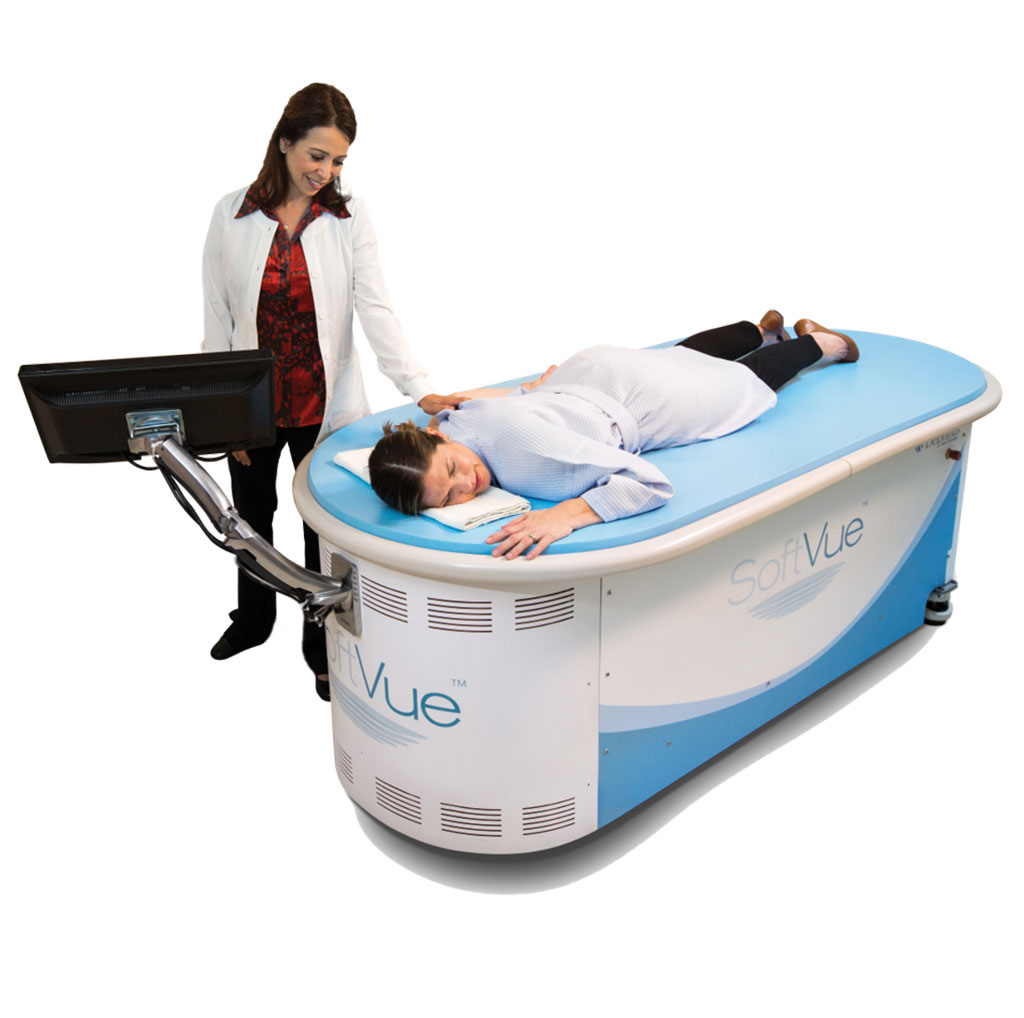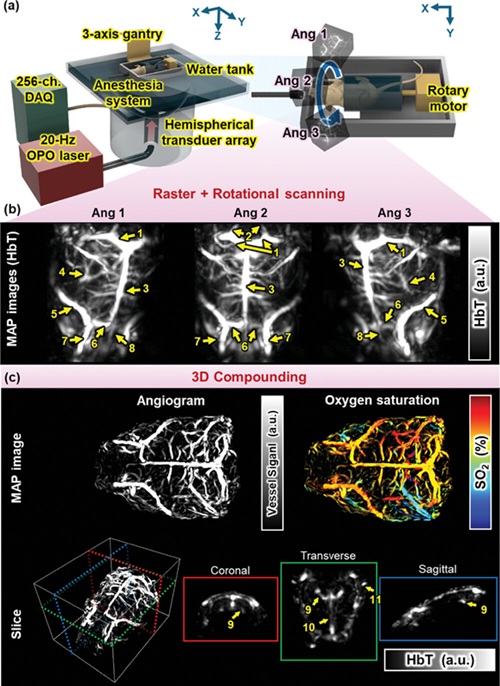Ultrasound Tomography May Improve Breast Cancer Risk Assessment
|
By MedImaging International staff writers Posted on 25 Mar 2020 |

Image: The SoftVue 3D whole breast ultrasound system (Photo courtesy of DMT)
A new study suggests that tissue sound speed, as derived from ultrasound tomography (UST) is a potential surrogate marker of breast density.
Researchers at the U.S. National Cancer Institute (NCI, Rockville, MD, USA), the Mayo Clinic (Rochester, MN, USA), George Washington University (GW; Washington, DC, USA), and other institutions conducted a case-control study to evaluate the relationship of sound speed and mammographic percent density (MPD) with breast cancer risk. The study compared 61 patients with a recent breast cancer diagnosis with 165 women with no history of breast cancer. The researchers used the Delphinus Medical Technologies (DMT; Novi, MI, USA) SoftVue 3D whole breast ultrasound system.
The results showed that increasing quartiles of whole breast volume-averaged sound speed were consistently, and more strongly, associated with increasing breast cancer risk than quartiles of mammographic percent density. According to the researchers, the findings are statistically significant, and suggest future opportunities for utilizing UST-breast cancer risk assessment, particularly in younger women with the absence of ionizing radiation. The study was published on January 29, 2020, in the Journal of Clinical Medicine.
“It is well-established that dense breast tissue is a breast cancer risk factor. Whole breast ultrasound tomography may provide stronger and more specific information about that risk than mammography, which may ultimately help to stratify the risk in order to suggest more personalized screening and interventions,” said study co-author Rachel Brem, MD, of GW. “We are encouraged by the study results that indicate the potential use of whole breast ultrasound to improve the accuracy of breast cancer risk assessment with a non-ionizing breast imaging modality.”
Breast density is a measurement of the amount of fatty tissue versus the amount of fibrous tissue in the breast. Because both cancer and dense tissue appear white on a mammogram, tumors often remain masked, resulting in almost one third of cancerous tumors in dense breasts being masked by the tissue during X-ray mammography. According to a 2014 report published by the Journal of the U.S. National Cancer Institute, an estimated 43.3% of women between the ages of 40 and 74 years old have extremely dense breast tissue.
Related Links:
U.S. National Cancer Institute
Mayo Clinic
George Washington University
Delphinus Medical Technologies
Researchers at the U.S. National Cancer Institute (NCI, Rockville, MD, USA), the Mayo Clinic (Rochester, MN, USA), George Washington University (GW; Washington, DC, USA), and other institutions conducted a case-control study to evaluate the relationship of sound speed and mammographic percent density (MPD) with breast cancer risk. The study compared 61 patients with a recent breast cancer diagnosis with 165 women with no history of breast cancer. The researchers used the Delphinus Medical Technologies (DMT; Novi, MI, USA) SoftVue 3D whole breast ultrasound system.
The results showed that increasing quartiles of whole breast volume-averaged sound speed were consistently, and more strongly, associated with increasing breast cancer risk than quartiles of mammographic percent density. According to the researchers, the findings are statistically significant, and suggest future opportunities for utilizing UST-breast cancer risk assessment, particularly in younger women with the absence of ionizing radiation. The study was published on January 29, 2020, in the Journal of Clinical Medicine.
“It is well-established that dense breast tissue is a breast cancer risk factor. Whole breast ultrasound tomography may provide stronger and more specific information about that risk than mammography, which may ultimately help to stratify the risk in order to suggest more personalized screening and interventions,” said study co-author Rachel Brem, MD, of GW. “We are encouraged by the study results that indicate the potential use of whole breast ultrasound to improve the accuracy of breast cancer risk assessment with a non-ionizing breast imaging modality.”
Breast density is a measurement of the amount of fatty tissue versus the amount of fibrous tissue in the breast. Because both cancer and dense tissue appear white on a mammogram, tumors often remain masked, resulting in almost one third of cancerous tumors in dense breasts being masked by the tissue during X-ray mammography. According to a 2014 report published by the Journal of the U.S. National Cancer Institute, an estimated 43.3% of women between the ages of 40 and 74 years old have extremely dense breast tissue.
Related Links:
U.S. National Cancer Institute
Mayo Clinic
George Washington University
Delphinus Medical Technologies
Latest Ultrasound News
- Tiny Magnetic Robot Takes 3D Scans from Deep Within Body
- High Resolution Ultrasound Speeds Up Prostate Cancer Diagnosis
- World's First Wireless, Handheld, Whole-Body Ultrasound with Single PZT Transducer Makes Imaging More Accessible
- Artificial Intelligence Detects Undiagnosed Liver Disease from Echocardiograms
- Ultrasound Imaging Non-Invasively Tracks Tumor Response to Radiation and Immunotherapy
- AI Improves Detection of Congenital Heart Defects on Routine Prenatal Ultrasounds
- AI Diagnoses Lung Diseases from Ultrasound Videos with 96.57% Accuracy
- New Contrast Agent for Ultrasound Imaging Ensures Affordable and Safer Medical Diagnostics
- Ultrasound-Directed Microbubbles Boost Immune Response Against Tumors
- POC Ultrasound Enhances Early Pregnancy Care and Cuts Emergency Visits
- AI-Based Models Outperform Human Experts at Identifying Ovarian Cancer in Ultrasound Images
- Automated Breast Ultrasound Provides Alternative to Mammography in Low-Resource Settings
- Transparent Ultrasound Transducer for Photoacoustic and Ultrasound Endoscopy to Improve Diagnostic Accuracy
- Wearable Ultrasound Patch Enables Continuous Blood Pressure Monitoring
- AI Image-Recognition Program Reads Echocardiograms Faster, Cuts Results Wait Time
- Ultrasound Device Non-Invasively Improves Blood Circulation in Lower Limbs
Channels
Radiography
view channel
AI-Powered Imaging Technique Shows Promise in Evaluating Patients for PCI
Percutaneous coronary intervention (PCI), also known as coronary angioplasty, is a minimally invasive procedure where small metal tubes called stents are inserted into partially blocked coronary arteries... Read more
Higher Chest X-Ray Usage Catches Lung Cancer Earlier and Improves Survival
Lung cancer continues to be the leading cause of cancer-related deaths worldwide. While advanced technologies like CT scanners play a crucial role in detecting lung cancer, more accessible and affordable... Read moreMRI
view channel
Ultra-Powerful MRI Scans Enable Life-Changing Surgery in Treatment-Resistant Epileptic Patients
Approximately 360,000 individuals in the UK suffer from focal epilepsy, a condition in which seizures spread from one part of the brain. Around a third of these patients experience persistent seizures... Read more
AI-Powered MRI Technology Improves Parkinson’s Diagnoses
Current research shows that the accuracy of diagnosing Parkinson’s disease typically ranges from 55% to 78% within the first five years of assessment. This is partly due to the similarities shared by Parkinson’s... Read more
Biparametric MRI Combined with AI Enhances Detection of Clinically Significant Prostate Cancer
Artificial intelligence (AI) technologies are transforming the way medical images are analyzed, offering unprecedented capabilities in quantitatively extracting features that go beyond traditional visual... Read more
First-Of-Its-Kind AI-Driven Brain Imaging Platform to Better Guide Stroke Treatment Options
Each year, approximately 800,000 people in the U.S. experience strokes, with marginalized and minoritized groups being disproportionately affected. Strokes vary in terms of size and location within the... Read moreNuclear Medicine
view channel
Novel PET Imaging Approach Offers Never-Before-Seen View of Neuroinflammation
COX-2, an enzyme that plays a key role in brain inflammation, can be significantly upregulated by inflammatory stimuli and neuroexcitation. Researchers suggest that COX-2 density in the brain could serve... Read more
Novel Radiotracer Identifies Biomarker for Triple-Negative Breast Cancer
Triple-negative breast cancer (TNBC), which represents 15-20% of all breast cancer cases, is one of the most aggressive subtypes, with a five-year survival rate of about 40%. Due to its significant heterogeneity... Read moreGeneral/Advanced Imaging
view channel
AI Model Significantly Enhances Low-Dose CT Capabilities
Lung cancer remains one of the most challenging diseases, making early diagnosis vital for effective treatment. Fortunately, advancements in artificial intelligence (AI) are revolutionizing lung cancer... Read more
Ultra-Low Dose CT Aids Pneumonia Diagnosis in Immunocompromised Patients
Lung infections can be life-threatening for patients with weakened immune systems, making timely diagnosis crucial. While CT scans are considered the gold standard for detecting pneumonia, repeated scans... Read moreImaging IT
view channel
New Google Cloud Medical Imaging Suite Makes Imaging Healthcare Data More Accessible
Medical imaging is a critical tool used to diagnose patients, and there are billions of medical images scanned globally each year. Imaging data accounts for about 90% of all healthcare data1 and, until... Read more
Global AI in Medical Diagnostics Market to Be Driven by Demand for Image Recognition in Radiology
The global artificial intelligence (AI) in medical diagnostics market is expanding with early disease detection being one of its key applications and image recognition becoming a compelling consumer proposition... Read moreIndustry News
view channel
GE HealthCare and NVIDIA Collaboration to Reimagine Diagnostic Imaging
GE HealthCare (Chicago, IL, USA) has entered into a collaboration with NVIDIA (Santa Clara, CA, USA), expanding the existing relationship between the two companies to focus on pioneering innovation in... Read more
Patient-Specific 3D-Printed Phantoms Transform CT Imaging
New research has highlighted how anatomically precise, patient-specific 3D-printed phantoms are proving to be scalable, cost-effective, and efficient tools in the development of new CT scan algorithms... Read more
Siemens and Sectra Collaborate on Enhancing Radiology Workflows
Siemens Healthineers (Forchheim, Germany) and Sectra (Linköping, Sweden) have entered into a collaboration aimed at enhancing radiologists' diagnostic capabilities and, in turn, improving patient care... Read more


















